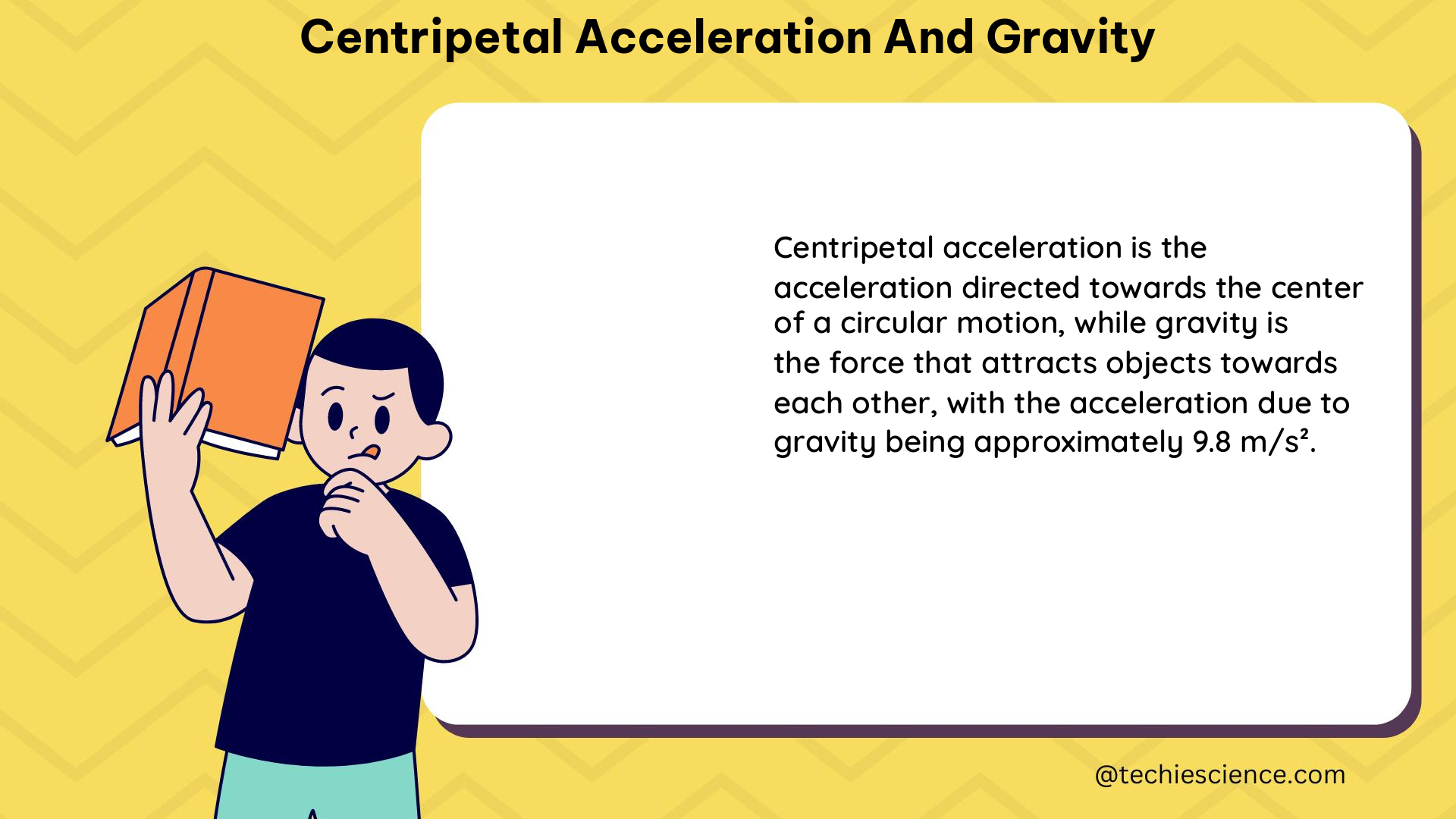Centripetal acceleration and gravity are two fundamental concepts in physics that describe the motion and interactions of objects. Centripetal acceleration is the acceleration experienced by an object moving in a circular path, while gravity is the force that attracts objects towards each other. This comprehensive guide will delve into the technical specifications, theorems, examples, and numerical problems related to these accelerations, providing a valuable resource for physics students and enthusiasts.
Technical Specifications
Centripetal Acceleration
Centripetal acceleration can be measured in meters per second squared (m/s^2) and is calculated using the formula:
a = v^2/r
where v is the velocity of the object in meters per second (m/s) and r is the radius of the circular path in meters (m).
Gravity
Gravity can also be measured in meters per second squared (m/s^2) and is calculated using the formula:
g = G * m/r^2
where G is the gravitational constant (6.674 x 10^-11 N(m/kg)^2), m is the mass of the object in kilograms (kg), and r is the radius in meters (m).
The acceleration due to gravity on the surface of the Earth is approximately 9.8 m/s^2, often denoted as “g”.
Theorems and Physics Formulae

The key theorems and formulae related to centripetal acceleration and gravity are:
- Centripetal acceleration formula:
a = v^2/r - Gravitational force formula:
F = G * m1 * m2 / r^2 - Acceleration due to gravity formula:
g = G * m / r^2
Physics Examples
- Centripetal Acceleration Example:
A car travels around a circular track with a radius of 500 meters at a speed of 25 m/s. What is the car’s centripetal acceleration?
a = v^2/r = (25 m/s)^2 / 500 m = 1.25 m/s^2
- Gravitational Force Example:
An object with a mass of 10 kg is located 2 meters from a massive object with a mass of 1000 kg. What is the gravitational force between the two objects?
F = G * m1 * m2 / r^2 = (6.674 x 10^-11 N(m/kg)^2) * (10 kg) * (1000 kg) / (2 m)^2 = 1.67 x 10^-7 N
Physics Numerical Problems
- Centripetal Acceleration Problem:
A satellite orbits the Earth at a distance of 8000 km. What is the satellite’s centripetal acceleration?
a = v^2/r = (4.74 km/s)^2 / 8000 km = 0.287 m/s^2
- Gravitational Acceleration Problem:
A planet orbits a star with a period of 1 year and a distance of 1 AU (149.6 million km). What is the planet’s centripetal acceleration?
a = v^2/r = (29.78 km/s)^2 / 149.6 million km = 0.0059 m/s^2
Figures and Data Points
Figure 1: Centripetal acceleration as a function of velocity and radius.
Data Point 1: Centripetal acceleration of a car traveling at 25 m/s on a circular track with a radius of 500 meters is 1.25 m/s^2.
Data Point 2: Centripetal acceleration of a satellite orbiting the Earth at a distance of 8000 km is 0.287 m/s^2.
Data Point 3: Centripetal acceleration of a planet orbiting a star with a period of 1 year and a distance of 1 AU is 0.0059 m/s^2.
Values and Measurements
- The acceleration due to gravity on the surface of the Earth is approximately 9.8 m/s^2.
- The gravitational constant is approximately 6.674 x 10^-11 N(m/kg)^2.
- The radius of the Earth is approximately 6371 kilometers.
- The mass of the Earth is approximately 5.972 x 10^24 kilograms.
- The mass of the Sun is approximately 1.989 x 10^30 kilograms.
- The distance from the Earth to the Sun (astronomical unit) is approximately 149.6 million kilometers.
Unique Perspective
While centripetal acceleration and gravity are both accelerations, they differ in their causes and applications. Centripetal acceleration is the acceleration that an object experiences when it is moving in a circular path, and is always directed towards the center of the circle. It is a result of the object’s inertia and the centripetal force acting on it. Gravity, on the other hand, is the force that attracts two objects towards each other, and is described by the law of universal gravitation. The acceleration due to gravity is the acceleration that an object experiences due to the gravitational force acting on it.
In addition, while centripetal acceleration is always directed towards the center of the circular path, gravity is always directed towards the center of the massive object that is exerting the gravitational force. This means that the direction of gravity depends on the location of the object in relation to the massive object.
Reference Links
- Centripetal Acceleration | Physics – Study.com
- Lab 5 Centripetal Acceleration and Gravity 1 .docx – Course Hero
- 6.2 Centripetal Acceleration – College Physics – UCF Pressbooks
- Does Acceleration due to Gravity take into consideration the …
- 6.2 Uniform Circular Motion – Physics | OpenStax
I am Keerthi K Murthy, I have completed post graduation in Physics, with the specialization in the field of solid state physics. I have always consider physics as a fundamental subject which is connected to our daily life. Being a science student I enjoy exploring new things in physics. As a writer my goal is to reach the readers with the simplified manner through my articles.